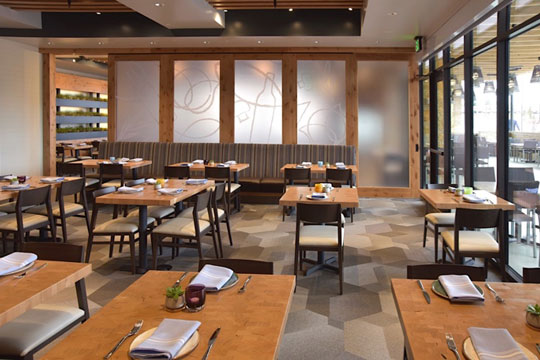Pan Asian Dining Islamabad: Relish Genuine Asian Meals
Savor Authentic Asian Food With a Pan-Asian Twist for a Culinary Adventure
Beginning on a culinary trip via genuine Asian cuisine, enhanced with a Pan-Asian spin, supplies a distinct chance to explore the abundant tapestry of flavors that specify the region's varied cooking customs. As you consider these luring recipes, consider the cultural narratives and historic influences that form them, each bite using a tale waiting to be found. pan asian dining Islamabad.

Exploring Pan-Asian Tastes
In the world of international gastronomy, Pan-Asian food stands apart for its remarkable diversity and the harmonious interplay of flavors from different Asian societies. This cooking strategy celebrates the distinct components and rich customs discovered across the continent, developing a tapestry of preferences that is both fascinating and enjoyable. Secret to Pan-Asian cuisine is its ability to stabilize contrasting tastes-- sweet, salty, spicy, and sour-- while highlighting the quality and top quality of each component.
From the umami-rich soy sauce of Japan to the fiery chili peppers of Thailand, Pan-Asian cuisine provides a substantial combination of flavors. These aspects are frequently integrated in inventive ways, enhancing recipes with layers of intricacy. For circumstances, making use of great smelling herbs such as lemongrass and cilantro, typical in Vietnamese and Thai food, includes a rejuvenating brightness to recipes, while the consolidation of coconut milk supplies a creamy, rich structure.
The emphasis on fresh produce and aromatic flavors makes certain that each meal is not only a feast for the palate however additionally for the detects. Pan-Asian food invites restaurants to start a culinary trip, discovering the huge and differed landscapes of Asian gastronomy with every bite.
Combination Recipes to Attempt
While Pan-Asian food is commemorated for its standard flavors, the modern cooking landscape is increasingly embracing combination meals that blend these timeless components with influences from other areas. This ingenious approach not just honors the rich heritage of Oriental culinary arts yet also introduces unique preference experiences that appeal to modern tastes buds.
An archetype of such a blend meal is the Korean-Mexican taco, where seasoned bulgogi beef is wrapped in a cozy tortilla, topped with kimchi and a hot gochujang-infused salsa. This combination marries the bold, mouthwatering flavors of Korea with the dynamic, fresh aspects of Mexican cuisine. Likewise, sushi burritos have gained popularity, integrating the delicate virtuosity of Japanese sushi with the hearty, hand-held comfort of a burrito, commonly featuring combination active ingredients like tempura shrimp and avocado with a drizzle of wasabi mayo.
One more significant meal is Thai curry ramen, which infuses the velvety, aromatic seasonings of Thai curry right into the soothing brew of typical Japanese ramen, developing a harmonious mix that entices the detects. These combination dishes extend beyond mere uniqueness; they stand for a cooking dialogue in between cultures, motivating exploration and advancement on the planet of Pan-Asian cuisine.
Important Active Ingredients and Seasonings
To absolutely appreciate Pan-Asian food, one should recognize the crucial components and seasonings that form its foundation. This diverse culinary style attracts from a rich tapestry of Oriental traditions, employing an unified mix of textures and tastes.
Aromatic aspects are critical, with lemongrass, garlic, and ginger being common across different Pan-Asian recipes. These components give a fragrant base that enhances the complexity of flavors. Seasonings such as star anise, cardamom, and cinnamon present warmth and character, resembling influences from regions like China and India.

Food Preparation Methods and Tips
Grasping the art of Pan-Asian food requires knowledge with its distinctive cooking strategies, each adding to the lively tapestry of tastes this cooking practice is celebrated for. Central to these methods is the stir-fry, a quick food preparation technique that preserves the dietary honesty and dazzling colors of active ingredients. Utilizing a wok, the stir-fry technique enables also heat circulation, crucial for attaining the particular structure and flavor equilibrium of Pan-Asian dishes.
One more essential technique is steaming, particularly common in Chinese cuisine. This mild approach keeps the all-natural tastes and nutrients of components, making it excellent for seafood and vegetables. Dumplings, a beloved staple, usually gain from steaming, causing soft, succulent appearances.
Cooking, also important, gives smoky midsts to dishes such as Korean bulgogi or Japanese yakitori (Chinese food Islamabad). This method commonly includes seasoning ingredients, enabling flavors to permeate deeply prior to cooking over an open fire or warmer
Finally, grasping the art of balancing tastes-- sweet, sour, salty, bitter, and umami-- is crucial. Correctly layering these elements can boost a meal from common to amazing, offering a complex and pleasing cooking experience that symbolizes the essence of Pan-Asian cuisine.
Dining Experiences Worldwide
Throughout the world, Pan-Asian italian restaurant food offers an unparalleled dining experience, commemorated for its rich tapestry of tastes and vivid presentations. This cooking phenomenon has transcended cultural borders, recording the hearts and palates of food fanatics worldwide. In worldwide cities like New York, London, and Sydney, Pan-Asian dining establishments function as fusions where cooking traditions from Thailand, Japan, China, and past converge, offering diners with a diverse mix of dishes that highlight the region's diversity.
The global charm of Pan-Asian food depends on its capability to supply both credibility and innovation. Chefs skillfully marry typical components such as lemongrass, soy sauce, and miso with modern strategies, leading to meals that are both acquainted and refreshingly brand-new. This combination allows restaurants to get started on a culinary journey that appreciates heritage while welcoming modernity.
Additionally, dining experiences are boosted via attentively made settings that reflect the values of Pan-Asian appearances. From minimal Japanese-inspired insides to vibrant Thai-themed areas, each restaurant offers a distinct ambiance that enhances the culinary offerings. Because of this, patrons are not simply consuming a dish but partaking in a social experience, making Pan-Asian eating a really worldwide phenomenon.
Final Thought
The expedition of Pan-Asian food offers a profound understanding of the intricate interplay of tastes and cooking traditions across Asia. By embracing blend dishes such as Thai curry ramen and sushi burritos, the culinary trip not only highlights the adaptability of conventional active ingredients however also showcases ingenious modern methods. This gastronomic experience, enriched by cooking techniques and crucial spices, offers an unique chance to appreciate the multiculturalism and culinary virtuosity that define Pan-Asian food on a worldwide range.
Getting started on a culinary journey with genuine Oriental cuisine, enhanced with a Pan-Asian spin, offers an one-of-a-kind possibility to check out the abundant tapestry of flavors that specify miss korea the area's diverse cooking practices.In the realm of worldwide gastronomy, Pan-Asian food stands out for its impressive important site variety and the harmonious interplay of flavors from different Eastern cultures. Secret to Pan-Asian food is its capability to balance different flavors-- pleasant, salted, spicy, and sour-- while highlighting the quality and quality of each ingredient.
